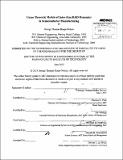| dc.contributor.advisor | Charles H. Fine. | en_US |
| dc.contributor.author | Heaps-Nelson, G. Thomas | en_US |
| dc.contributor.other | Massachusetts Institute of Technology. Engineering Systems Division. | en_US |
| dc.date.accessioned | 2013-09-24T19:43:23Z | |
| dc.date.available | 2013-09-24T19:43:23Z | |
| dc.date.copyright | 2013 | en_US |
| dc.date.issued | 2013 | en_US |
| dc.identifier.uri | http://hdl.handle.net/1721.1/81108 | |
| dc.description | Thesis (Ph. D.)--Massachusetts Institute of Technology, Engineering Systems Division, 2013. | en_US |
| dc.description | Cataloged from PDF version of thesis. | en_US |
| dc.description | Includes bibliographical references (p. 269-278). | en_US |
| dc.description.abstract | This dissertation demonstrates that valuable strategic insight and a reasonable measure of predictive power can be obtained by developing and analyzing context-rich parsimonious game theoretic strategy models during large technology transitions in concentrated industries. Such models enable clear and compact analysis of oligopolistic competitive dynamics which are typically addressed by more informal processes in much of current managerial practice. This result is established by constructing 3-player game theory models of two prominent, ongoing technology transitions in semiconductor manufacturing: EUV lithography (EUVL) and 450mm silicon wafers. The iterative multi-data-source process used for establishing appropriate game structures and payoff estimates is described in detail. Contextual realism was augmented by in-depth behavioral analysis of select industry players and by interactions with the equipment supplier facing groups at a semiconductor device manufacturer. The robust game theoretic prediction from the EUV lithography R&D model was subsequently validated by the announcement of a series of chipmaker investments totaling greater than $6B in the largest photolithography supplier in July/August 2012 (including significant financial assistance to EUV equipment readiness) and by several other industry financing events in late 2012. Although no such distinct confirmatory evidence exists for the 450mm wafer model predictions, it was found to have substantial face validity. Based on learning from the modeling efforts, criteria are proposed for determining whether other technology transitions will be amenable to such analysis. Generalizability to similar transitions in other industries (including aerospace and automotive) is discussed. Industry strategists, technology and business strategy scholars, and innovation policy makers should find the work of interest. | en_US |
| dc.description.statementofresponsibility | by George Thomas Heaps-Nelson. | en_US |
| dc.format.extent | 278 p. | en_US |
| dc.language.iso | eng | en_US |
| dc.publisher | Massachusetts Institute of Technology | en_US |
| dc.rights | M.I.T. theses are protected by
copyright. They may be viewed from this source for any purpose, but
reproduction or distribution in any format is prohibited without written
permission. See provided URL for inquiries about permission. | en_US |
| dc.rights.uri | http://dspace.mit.edu/handle/1721.1/7582 | en_US |
| dc.subject | Engineering Systems Division. | en_US |
| dc.title | Game theoretic models of inter-firm R&D dynamics in semiconductor manufacturing | en_US |
| dc.title.alternative | Game theoretic models of inter-firm research and development dynamics in semiconductor manufacturing | en_US |
| dc.type | Thesis | en_US |
| dc.description.degree | Ph.D. | en_US |
| dc.contributor.department | Massachusetts Institute of Technology. Engineering Systems Division | |
| dc.identifier.oclc | 858278988 | en_US |
